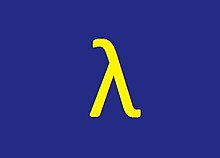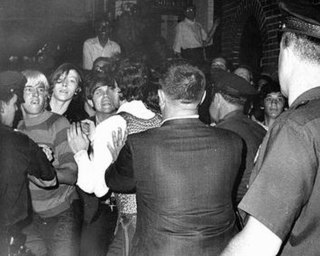
The Stonewall riots, also known as the Stonewall uprising, Stonewall rebellion, or simply Stonewall, were a series of protests by members of the gay community in response to a police raid that began in the early morning hours of June 28, 1969, at the Stonewall Inn in the Greenwich Village neighborhood of Lower Manhattan in New York City. Patrons of the Stonewall, other Village lesbian and gay bars, and neighborhood street people fought back when the police became violent. The riots are widely considered the watershed event that transformed the gay liberation movement and the twentieth-century fight for LGBT rights in the United States.
This is a list of notable events in the history of LGBT rights that took place in the year 1970.

Gay Liberation Front (GLF) was the name of several gay liberation groups, the first of which was formed in New York City in 1969, immediately after the Stonewall riots. Similar organizations also formed in the UK, Australia and Canada. The GLF provided a voice for the newly-out and newly radicalized gay community, and a meeting place for a number of activists who would go on to form other groups, such as the Gay Activists Alliance and Street Transvestite Action Revolutionaries (STAR) in the US. In the UK and Canada, activists also developed a platform for gay liberation and demonstrated for gay rights. Activists from both the US and UK groups would later go on to found or be active in groups including ACT UP, the Lesbian Avengers, Queer Nation, Sisters of Perpetual Indulgence, and Stonewall.

The gay liberation movement was a social and political movement of the late 1960s through the mid-1980s in the Western world, that urged lesbians and gay men to engage in radical direct action, and to counter societal shame with gay pride. In the feminist spirit of the personal being political, the most basic form of activism was an emphasis on coming out to family, friends, and colleagues, and living life as an openly lesbian or gay person.

The NYC Pride March is an annual event celebrating the LGBTQ community in New York City. The largest pride parade in North America and among the largest pride events in the world, the NYC Pride March attracts tens of thousands of participants and millions of sidewalk spectators each June. The parade route through Lower Manhattan traverses south on Fifth Avenue, through Greenwich Village, passing the Stonewall National Monument, site of the June 1969 riots that launched the modern movement for LGBTQ+ rights.
Street Transvestite Action Revolutionaries (STAR) was a gay, gender non-conforming and transvestite street activist organization founded in 1970 by Sylvia Rivera and Marsha P. Johnson, subculturally-famous New York City drag queens of color. STAR was a radical political collective that also provided housing and support to homeless LGBT youth and sex workers in Lower Manhattan. Rivera and Johnson were the "mothers" of the household, and funded the organization largely through sex work. STAR is considered by many to be a groundbreaking organization in the queer liberation movement and a model for other organizations.

LGBT pride is the promotion of the self-affirmation, dignity, equality, and increased visibility of lesbian, gay, bisexual, and transgender (LGBT) people as a social group. Pride, as opposed to shame and social stigma, is the predominant outlook that bolsters most LGBT rights movements. Pride has lent its name to LGBT-themed organizations, institutes, foundations, book titles, periodicals, a cable TV channel, and the Pride Library.
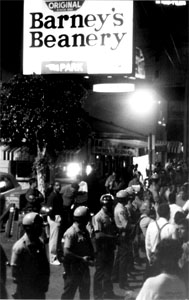
A zap is a form of political direct action that came into use in the 1970s in the United States. Popularized by the early gay liberation group Gay Activists Alliance, a zap was a raucous public demonstration designed to embarrass a public figure or celebrity while calling the attention of both gays and straights to issues of gay rights.
Mark Allan Segal is a social activist and author. He participated in the Stonewall riots and was one of the original founders of the Gay Liberation Front where he created its Gay Youth program. He was the founder and former president of the National Gay Newspaper Guild and purchased the Philadelphia Gay News. He has won numerous journalism awards for his column "Mark my Works," including best column by The National Newspaper Association, Suburban Newspaper Association and The Society of Professional Journalists.
New York has a long history of LGBT community building, activism, and culture which extends to the early history of the city.
Peter Fisher was an American author and gay rights activist. An alumnus of Amherst College and Columbia University, he served in the US Air Force prior to becoming an early member of the Gay Activists Alliance, a protest group that split off from the Gay Liberation Front after the Stonewall riots with the goal of "writing the revolution into law." Fisher led a number of the "zaps", or protests targeted at public figures, organized by the Gay Activists Alliance, as well as serving as an unofficial historian for the group.

New York City has been described as the gay capital of the world and the central node of the LGBTQ+ sociopolitical ecosystem, and is home to one of the world's largest LGBTQ populations and the most prominent. Brian Silverman, the author of Frommer's New York City from $90 a Day, wrote the city has "one of the world's largest, loudest, and most powerful LGBT communities", and "Gay and lesbian culture is as much a part of New York's basic identity as yellow cabs, high-rise buildings, and Broadway theatre". LGBT travel guide Queer in the World states, "The fabulosity of Gay New York is unrivaled on Earth, and queer culture seeps into every corner of its five boroughs". LGBT advocate and entertainer Madonna stated metaphorically, "Anyways, not only is New York City the best place in the world because of the queer people here. Let me tell you something, if you can make it here, then you must be queer."
Lesbian Feminist Liberation was a lesbian rights advocacy organization in New York City formed in 1972.
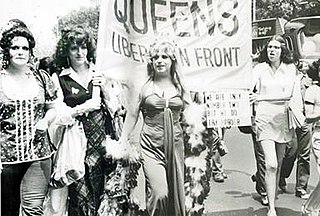
Queens Liberation Front (QLF) was a homophile group primarily focused on transvestite rights advocacy organization in New York City. QLF was formed in 1969 and active in the 1970s. They published Drag Queens: A Magazine About the Transvestite beginning in 1971. The Queens Liberation Front collaborated with a number of other LGBTQ+ activist groups, including the Gay Activists Alliance and the Street Transvestite Action Revolutionaries.
Martin "Marty" Robinson was an American gay activist, "known for his provocative protests."
Diego Viñales was a former Argentinian student who was swept up in a police raid on the Snake Pit gay bar in New York's Greenwich Village in March 1970. The raid at the Stonewall Inn that had sparked rioting and gay activism had occurred the previous summer, but such raids were still common. Taken to the police station, Viñales, who was on an expired student visa and fearful of deportation, tried to escape by jumping out a second floor window. He landed on a spiked fence. Viñales suffered grave injuries, but survived and was arrested. Protest marches in response to the day's events were led by gay activist groups formed in the wake of Stonewall, and helped spark greater community awareness and interest in the upcoming Christopher Street Liberation Day events scheduled for 28 June to commemorate the first anniversary of the Stonewall riots.
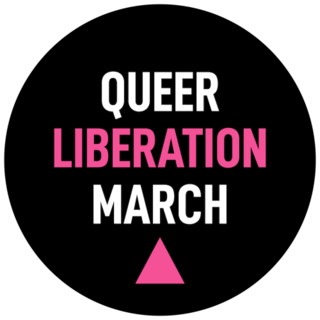
The Queer Liberation March is an annual LGBT protest march in Manhattan, organized by the Reclaim Pride Coalition as an anti-corporate alternative to the NYC Pride March.
The National LGBTQ Wall of Honor is an American memorial wall in Greenwich Village, Lower Manhattan, New York City, dedicated to LGBTQ "pioneers, trailblazers, and heroes". The wall is located inside of the Stonewall Inn and is a part of the Stonewall National Monument, the first U.S. National Monument dedicated to LGBTQ rights and history. The first fifty nominees were announced in June 2019, and the wall was unveiled on June 27, 2019, as a part of the Stonewall 50 – WorldPride NYC 2019 events. Each year five additional names will be added.
Marc Rubin was an author and activist involved in the gay liberation movement.
The New York City Gay Rights Bill was an anti-discrimination bill passed on March 20, 1986, in a New York City Council vote of 21–14 as Local Law 2 of 1986.
